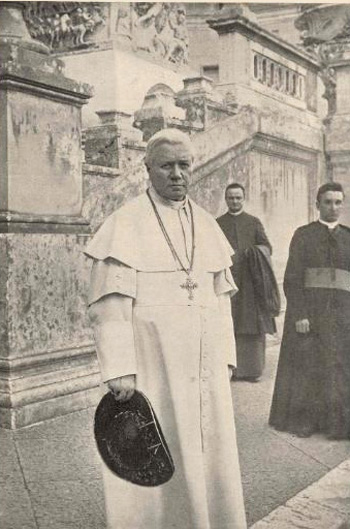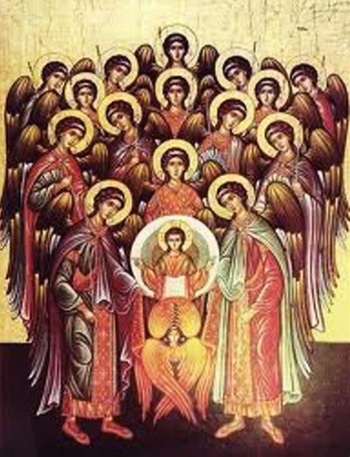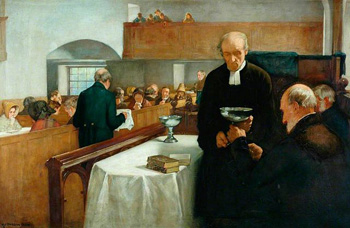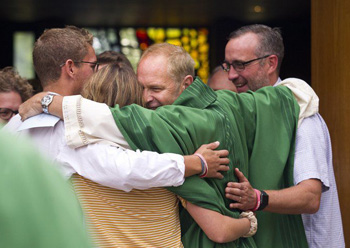The Dignity of Worship
We will recall that Pope Pius X made it a priority to provide for the "sanctity and dignity of the temple" as a suitable backdrop for the ceremonies through which the holy mysteries are enacted. (1) Fr. Bacuez devoted a whole section of his book to describing the pivotal role of the Minor Orders and the Sub-Diaconate that contributed substantially to "the worship of God in a manner worthy of His majesty." (2) Without them, what would the liturgy be like?
Pius X: Sanctity & dignity, a priority in the ceremonies
Armed with this information from a genuinely traditional source, we can see the effects of the loss of the Minor Orders in the Novus Ordo liturgy. Without the sequential ordinations through the grades of the Church's ministry, the hierarchies of office are not clearly delineated; the "verticality" of worship directed to God is impaired; all the ministers (including the Bishop) stand or sit on the same level; the distinction between the clergy and laity is blurred, and women compete with men in the sanctuary to perform liturgical offices. Little in the way of differentiation (4) is evident in the new liturgy to reflect the difference between sacred and profane ‒ or even between God and man. So it is not surprising that it fails to reflect either the "celestial hierarchies" or the created order of the world.
Fr. Bacuez explained further:
"To be worthy of God and profitable to the faithful this worship must have a certain solemnity, speak both to the mind and the heart, and be calculated to arouse in souls holy sentiments and pious feelings.
"Now would these effects be forthcoming if there were but one Order of ministers and but one function to be performed? With the disappearance of the numerous officiating ministers and divers ceremonies there would in a great measure disappear also the imposing spectacle of the divine mysteries, their symbolical meanings the vestiges of the old worship, the memories of Our Savior's history, the anticipations of the heavenly liturgy, the edifying expressions of charity, mutual respect, deference and subordination, which the ministers of the sanctuary in their relations with one another place unceasingly before the eyes of the faithful." (5)

The liturgy should reflect the celestial hierarchies
Fr. Bacuez depicted, with prophetic accuracy, the negative consequences that would ensue if the Church violated her duty to receive and pass on the tradition of Minor Orders:
"The services would be marked only by their coldness and monotony, and it would be said of Catholics what is often said of Protestants, that they have but an abstract, formless religion, one incapable of appealing to the emotional faculties, and little in harmony with the sentiments of the majority of the human race." (6)
Even if few people were conversant with the technical expression lex orandi lex credendi, most were aware of the connection between worship and belief, and how the former influences and shapes the latter. Fr. Bacuez was expressing this axiom in practical terms: take away the imposing structures of the Roman Rite (in this instance the Minor Orders and Sub-Diaconate) and we would be left with a liturgy that is banal, rationalistic and cold in the sense that it fails to inspire devotion and keep the flame of Faith alive.

The simplification of the Novus Ordo Mass comes close to the dryness of Protestant worship
And yet, the Novus Ordo creators deliberately excised from the liturgy as much distinctively Catholic symbolism as possible, following the example of the 16th-century Protestants and the leaders of the Liturgical Movement, both of whom sought to dampen the external expression of religious devotion.
A'dumb spectator'
In the decades before Vatican II, the faithful were constantly berated by Church leaders (including Popes) for being what they termed "dumb spectators" during Mass – as if their silent prayerfulness was a disease for which "active participation" was the cure. But what the reformers failed to appreciate was that by looking at the action unfolding in the sanctuary, the faithful become immersed in the sacred mysteries, for the Catholic liturgy speaks to the soul through the senses, particularly that of sight. Fr. Bacuez captured this truth, recognized by all generations of Catholic worshippers before the Liturgical Movement altered the perception of most:
"She [the Church] loves to speak to the eye by her worship, her rites, her solemnities, her hierarchy; and in her sanctuaries, just as in nature, every thing is full of meaning Nihil est sine voce. (I Cor. 14: 10) With the Church, with Our Savior, there is not one act that has not a certain signification, indicative of some plan or of some hidden operation." (7)
His main emphasis here was, of course, on the Minor Orders and the Sub-Diaconate, and how they display the hierarchical nature of the Church to all onlookers. Contrariwise, one is hard-pushed to discern the particular nature of the remaining clerical orders in the Novus Ordo liturgy because of their reduction in numbers (there is only one clerical order below the priesthood instead of the traditional six), their altered identity and the inter-mingling of lay participants in the sanctuary performing the same roles.
The wilful promotion of ignorance
This, we now know, was an act of deliberate obfuscation on the part of progressivist liturgists who had been working hard in commissions and committees to confuse and cloud the truth about the hierarchical Constitution of the Church as willed by her Founder: her monarchical nature is no longer openly proclaimed and demonstrated in the new rites. Clearly, those responsible for the reforms had their own reasons for the faithful "not to know."
A faith-changing experience for Novus Ordo priests & faithful

The priest is now considered on the same level as the parishioners
With the new emphasis on the whole People of God as the active agent in building up God's Kingdom by exercising their individual gifts and "charismas," the Minor Orders were made redundant. By the same token, candidates for ordination would lose the sense of their primary vocation which is the worship of God, and priests their unique status as ministers of the Word and the Eucharist.
Baptism seen, like death, as the great leveller (8)
According to a 2019 statement of the U.S. Conference of Bishops, Baptism, not ordination, is "the foundation for how we conceive of the Church."
"Our focus in thinking about the Church, and in celebrating its reality, must be on the unity of the people of God that is grounded in our common baptism, and on a corresponding understanding of the diversity of roles and charismas within that radically unified people." (9)
As a result of this revolutionary ferment, the once universally recognizable word "ministry" – designating the offices of the ordained – was radically redefined to cover the "inclusive" category of all the baptized. Along with the new "Baptism-conscious" narrative (first introduced by Beauduin and Virgil Michel in the early 20th century) came a recrudescence of old modernist ideas and beliefs animating a new ecclesial framework for the construction of what we now know as the "Synodal Church" of the People of God.
To be continued
- Pope Pius X, Tra le sollecitudini, 1903.
- Ibid., p. 121.
- Ibid., p. 7.
- There are no specific rubrics for the placement of the Bishop's Chair. According to the new Ceremonial of Bishops, this could be anywhere in the sanctuary, thus opening the door to subjective opinion. The General Instruction of the Roman Missal gives a number of options for the location of the priest's chair, but insists that it should face the people, thus giving the impression that he wishes to be considered as one of the congregation.
- Ibid., p. 134.
- Ibid., pp. 134-135.
- Ibid., p. 138.
- "Omnia mors aequat" (death levels everything), from Claudian, De Raptu Proserpinae, book II, line 302.
- Msgr. Brian Bransfield, General Secretary, United States Conference of Catholic Bishops, 'Vocation and Mission,' May 29, 2019.
Posted January 3, 2022
No comments:
Post a Comment